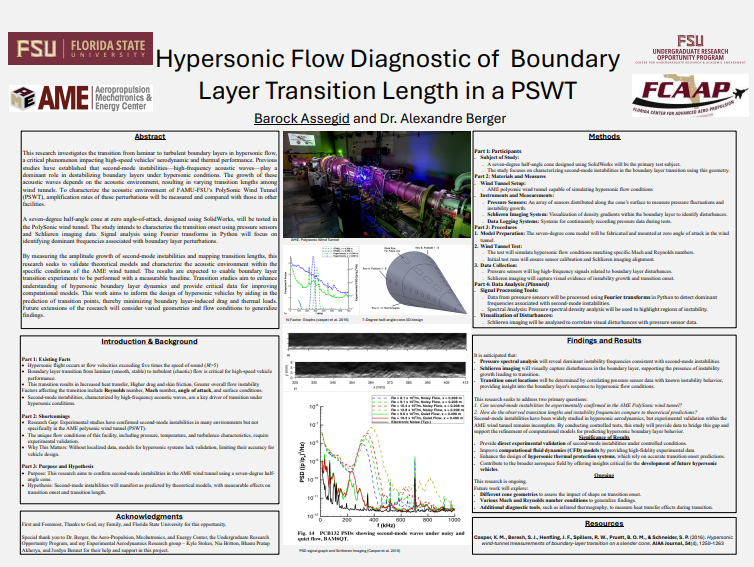Research Symposium
25th annual Undergraduate Research Symposium, April 1, 2025
Barock Assegid Poster Session 3: 1:45 pm - 2:45 pm/ Poster #58

BIO
I am Barock Assegid, a second-year Mechanical Engineering student at the FAMU-FSU College of Engineering from Palm Beach, Florida. My interests in Engineering include dynamic systems and aeronautics, with the eventual goal of working within the defense industry. Besides engineering, I enjoy reading, philosophy, and sports.
Hypersonic Flow Diagnostic of Boundary Layer Transition Length in a PSWT
Authors: Barock Assegid, Dr. Alexandre BergerStudent Major: Mechanical Engineering
Mentor: Dr. Alexandre Berger
Mentor's Department: Mechanical Engineering Mentor's College: FAMU-FSU College of Engineering Co-Presenters:
Abstract
This research investigates the transition from laminar to turbulent boundary layers in hypersonic flow, a critical phenomenon impacting high-speed vehicles' aerodynamic and thermal performance. Previous studies have established that second-mode instabilities—high-frequency acoustic waves—play a dominant role in destabilizing boundary layers under hypersonic conditions. The growth of these acoustic waves depends on the acoustic environment, resulting in varying transition lengths among wind tunnels. To characterize the acoustic environment of FAMU-FSU’s PolySonic Wind Tunnel (PSWT), amplification rates of these perturbations will be measured and compared with those in other facilities.
A seven-degree half-angle cone at zero angle-of-attack, designed using SolidWorks, will be tested in the PolySonic wind tunnel. The study intends to characterize the transition onset using pressure sensors and Schlieren imaging data. Signal analysis using Fourier transforms in Python will focus on identifying dominant frequencies associated with boundary layer perturbations.
By measuring the amplitude growth of second-mode instabilities and mapping transition lengths, this research seeks to validate theoretical models and characterize the acoustic environment within the specific conditions of the AME wind tunnel. The results are expected to enable boundary layer transition experiments to be performed with a measurable baseline. Transition studies aim to enhance understanding of hypersonic boundary layer dynamics and provide critical data for improving computational models. This work aims to inform the design of hypersonic vehicles by aiding in the prediction of transition points, thereby minimizing boundary layer-induced drag and thermal loads. Future extensions of the research will consider varied geometries and flow conditions to generalize findings.
Keywords: Aeronautics, Engineering, Hypersonic, Aerospace, Aerodynamics


